Diary by artistic director at NXT, Madeleine Kate McGowan, from her journey to Yale School of Architecture this Spring 2024, as she was invited as guest-reviewer on the final presentations by students attending the seminar ‘Feral Surfaces – Multi Species Architecture’.
—
While the cherry-blossom trees were in early bloom in New York City, I jumped on a train from Harlem to Yale University in New Haven. I had been invited by architect, Ariane Harrison to visit and give feedback to her students attending the seminar Feral Surfaces – Multi Species Architecture. Ariane is co-founder of Harrison Atelier, a Brooklyn based architecture firm which explores how to build for more than one species, proposing cohabitation and environmental activism.
Ariane’s seminar at Yale School of Architecture, examines the concepts and buildings that characterize the discourse on posthuman architecture over the past decade, asking whether architecture as a discipline has demonstrated a capacity to move away from its 500 years of anthropocentrism. As a part of the seminar, I had been invited earlier in 2024, to introduce the students to our New European Bauhaus project, The Garden Caretaker. Furthermore our Nybrogade Press publication Natural Artefacts – Nature, Repair, Responsibility written by Marion Waller, has now become a regular text as part of the seminar curriculum.
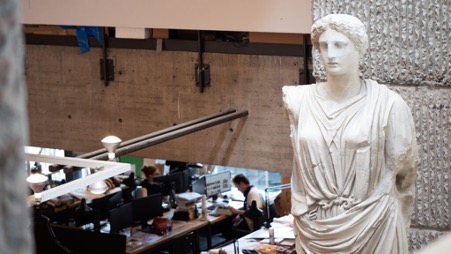
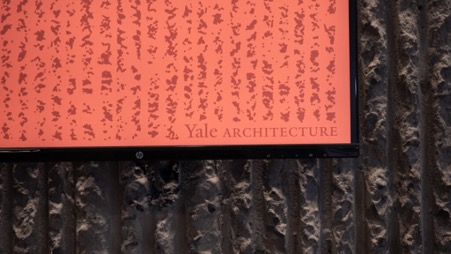
Photos by Madeleine Kate McGowan, from Rudolph Hall, Yale School of Architecture.
The day I arrive, the student protests that started at Columbia University, had emerged at Yale, taking over a large green area in the central part of campus. Community dining, free healthcare, libraries, written statements in support of Palestine, all fill what the students call the ‘liberated zone’. A description that could well refer to the Temporary Autonomous Zone (TAZ) as articulated by anarchist poet and social activist Hakim Bey. TAZ was conceived in the late 1980s when the Cold War still dominated geopolitical thought and the Internet was in its infancy. Bey suggests that the TAZ looks simply to create a space or enclave for an alternative to power.
I speak to one of the young women eating her lunch in the encampment and she tells me, that the past two weeks of activism and protest, have been the best two weeks of her life. The area is full of both students and faculty. Some professors are having a casual chat, others are having lunch whilst student groups are engaged in class sessions in circle formations on the green. Some are drinking coffee others chatting about the most effective ways of organising themselves so they don’t suffer from burn-out, as many activists do.
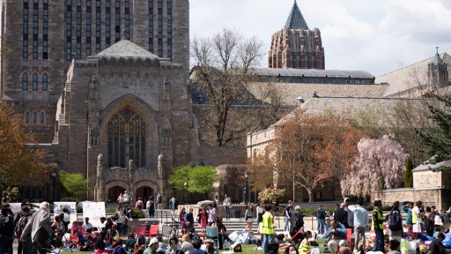
Yale campus, the ‘Liberated Zone’. Photos Madeleine Kate McGowan.
Another way of challenging the status quo is by looking into ways of destabilising the so-called ‘anthropocentric delirium of culture’ – where humans are always at the centre of everything.
When we start our review of the student projects, we are seated in an auditorium at the old Yale brutalist building, Rudolph Hall, which houses the Yale School of Architecture. Several students are slightly late and turn up with hoarse throats and ripped voices “from screaming all night” as they explain. The proposals and presentations are exciting and captivating. Students are engaging in passionate explorations of the possibilities of inter-species cohabitations. New ecological aesthetics and surfaces shaped for the pleasure and habitability of among others, bees, snails, and local birds.
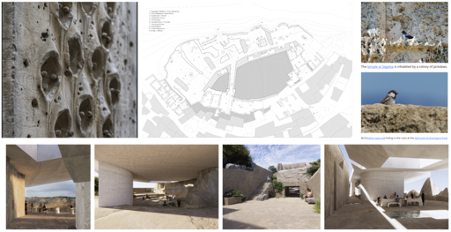
Student proposal by Emma Sherefkin, proposing spaces for bees and humans.
“…we find these qualities – animal, wilderness, funerary rite, and the dead – tangling together to invoke the losses caused by the acidifying oceans, heating atmospheres, and planetary urbanization of the Anthropocene…”
“We use the term ‘feral’ to refer to animals that are wild or untamed, also to animals that have abandoned a domesticated environment for the wilderness. Yet in the etymology of this word lies another meaning derived from the Latin Feralis, meaning funerary, or belonging to the dead. Intoday’s Anthropocene period, in which humans’ role as the largest evolutionary force on the planet coincides with the current sixth mass extinction event for nonhuman species, these two sets of meanings take on a distinctive resonance. In one word, we find these qualities – animal, wilderness, funerary rite, and the dead – tangling together to invoke the losses caused by the acidifying oceans, heating atmospheres, and planetary urbanization of the Anthropocene.” So explains Ariane Harrison, who’s vision is the passion behind this seminar, inviting students to speculate into preferred futures where cities become habitable for many more species than merely human.
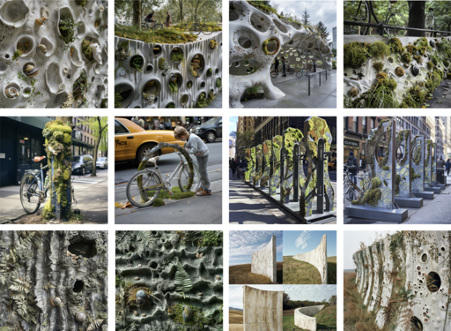
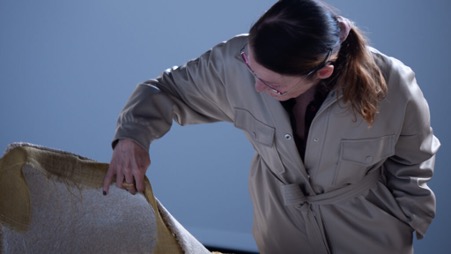
Above: Student proposal by Janice Chu, introducing elements for snails within the city.
Below: Ariane Harrison exploring material tests at Yale School of Architecture